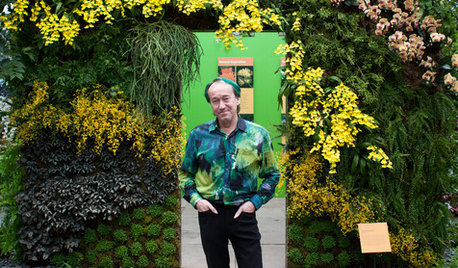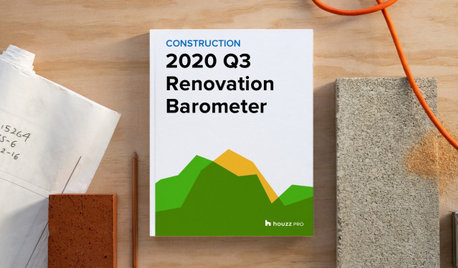April 2020, Week 3
Okiedawn OK Zone 7
4 years ago
Featured Answer
Sort by:Oldest
Comments (92)
Okiedawn OK Zone 7
4 years agoOkiedawn OK Zone 7
4 years agoRelated Discussions
February 2020, Week 3
Comments (59)dbarron, The one thing I regret most about our particular location is all the wildlife from the river bottom lands that move upland onto our property in drought, searching for food....including gazillions of snakes, and they all want to eat eggs and chicks. If I never see another chicken snake, rat snake, or any other snake (copperheads are fairly common) inside the chicken coop again in my life, I'll be happy. We should have bought land on top of a big hill, not in a creek hollow in a river valley. On the other hand, our friends who built their home 2 miles away from us up on top of a hill had their house struck by lightning 10 or 12 years ago, so I guess every location has its risk...but they rarely had snakes up around the house. Of course, they didn't have chickens either. It was even worse when we had guineas. I always heard that guineas would help keep snakes away, but in our case, I think the incessant yakking of the guineas called in the snakes to come eat the keats. We killed one black rat snake one day they had eaten four half-grown keats. I never would have thought it could eat even one because they were a pretty good size, but it ate four. It does not help that my husband thinks all snakes are good snakes and would patiently relocated rat snakes and chicken snakes to some other place on our property---maybe 200 or 300 yards from the chicken coop. He didn't want to kill them. Well, they'd be back in the chicken coop before he made it back to the house and he finally had to admit defeat in that area and start killing them. One of the great snake memories is that 4 wooden eggs, placed in chicken nesting boxes to get young laying hens to actually lay eggs in the nesting boxes all disappeared. Obviously a snake swallowed them up. I guess it saw the error of its ways and regurgitated the 4 wooden eggs onto the ground, behind the Jeep's rear tires, about 25' away from the chicken coop. We had a good laugh about that. We hit 22 and 23 degrees for two consecutive nights, even though the days have been pretty warm. I'm so tired of the cold nights and frosts, but the fruit trees do not care and have been blooming in our neighborhood for 4 or 5 days now. Of course, it is far too early but there those blooms are. I felt really cold at 22 and 23 until I read your 17! Jennifer, Did he get kicked in the throat? Or the lungs? Maybe something is damaged. Or, maybe he just figured out it is better to stay quiet and fly under the radar. I'm glad your procedure went well and hope you are healing well. Kim, What Moni said....and, garden soil is meant for adding to raised beds and such, not for containers. It is too heavy to do well in containers in general, no matter what brand it is. dbarron, I am crossing my fingers and hoping the Sunday rain misses us, because if it does, I think I can finally get into the garden to at least clean out the raised beds beginning Monday. (This is a grandkid weekend, so no work tomorrow afternoon...). We'll see. The landscaping work "might" be able to be started, somehow, next weekend if the rain will stay away. Our soil still is too wet and heavy to rent a sod cutter, but we might be able to work on something else. If we get pretty much any rain at all between now and next weekend, I don't think we could do anything in the yard. It is just now to the point that we can walk in it without 'squishing' up the mud and leaving big footprints behind. The young dog who adopted us a few months ago likes to dig in the mud....he likes to dig in anything...so he comes in every day with a big chunk of mud dried to his nose, and I have to crack it and scrape it off his nose. He should be as tired of mud as I am. I can tell y'all that a big chunk of dried mud on a dog's nose is not a fashion statement. Jennifer, Since I cannot garden in any shape, form or fashion, I'm just working on other stuff, and if I stay off FB, it is amazing how productive I can be! lol. This is a grandchild weekend, so it has been filled so far with arts and crafts, shopping, cooking meals together, going to the park to play at the big playground, eating dinner out, "Family Movie Night" with ice cream, popcorn and videos every night, bubble baths and bath bombs for little girls, playing with the kittens, etc. Even if it wasn't so muddy, there probably wouldn't be much gardening going on because they are getting a full dose of it at home now with new beds and plants everywhere. How ironic that I am trying to give the grandkids a break from gardening....but it is because Chris has become so gardening obsessed. (grin) Lillie went to a sleepover birthday party last night and tried to learn how to use a hoverboard today, which resulted in a face-first collision into a parked car at her friend's house. That happened just before Chris picked her up and brought her here today, so we've been watching her eye swell and turn black, while making up silly stories that start out with "you should see how the other guy looks..." Of course, the drama of her accident makes her little sister wish she had gotten hurt and had a matching black eye, though I've tried to tell her that there's some things about her big sister's life that she doesn't want to copy. Kim, I'm sorry things are not working out as planned and hope it all ends well. Nancy, I'm fine. Other projects that are not garden-related are taking precedence during our aggravating rainy season, and staying off FB as much as possible gives me the time to work on them. I feel like I spend too much time on FB, so I'm trying to make a massive change there. Know what? I don't miss it as much as I thought I would. The less time I spend on FB, the less I miss it. I'm a stay-at-homer too and pretty much would stay home all the time if I could, but there's that pesky business of buying groceries and going to the feed store, etc., that need to be done at least occasionally. I don't dislike people, but at the same time, I'm happier at home. While we were out with the girls today, we missed a fire and, I am not going to lie, when the fire page popped up on the fire app on my phone, I glanced at it and said "yay, we're not home, can't go" which is totally the wrong attitude, but I don't care....that's how I felt. Even if we had been home, I wouldn't have gone because I am never going to take the girls to a fire as they do not belong there. The windy season approaches and I'm sure I'll spend too much time out at fires then, and the muddy ground makes it hard because you can't park/drive anywhere off paved roads or you'll get stuck, and we almost always have to get off the paved roads. I'm dreading that part of Spring, and it usually hits here in March. Jen, That's a lot of mulch hauling. I bet y'all all feel it in your muscles now and for the next few days. That heavy hauling is the part of gardening I really don't care for any more. I've done it all my life, and I'm getting to the point that my 60-year-old body doesn't want to do it any more. Yet, the need for heavy physical labor in the garden never really ends, so I guess I'll keep doing it for as long as I can. The rain largely missed us this week--only a quarter inch or so, and that has allowed for more surface drying. It all still is real wet underneath though. I think we are not quite as wet as Larry now, but cool-season planting still is questionable. I'm going to evaluate the soil in the tallest raised beds this week to see if they can dry out enough for onions. If not, there won't be any planted this year, and likely not potatoes either. I'm supposed to not plant any nightshades in the front garden this year as a form of crop rotation anyway, so I should just relax and stop feeling like I should be planting potatoes in there somewhere. I don't have hardware-cloth beds anywhere else to protect them from voles, so planting them out in the back garden is not a part of the plan either. I toyed with not having any veggies at all this year except for the peppers and tomatoes in large pots by the garage, but since we cannot do any landscaping in our mud pit of a yard, the raised beds in the front garden are looking more and more appealing now. I'm tempted to cover the whole side yard and back yard with black plastic and leave it for a year to kill the grass, but y'all know I won't because I am not that patient. I just want for the weather to cooperate for once. Spring is busting out all over here...random fruit trees are blooming and ornamental pears are blooming here and there. Tim said they were blooming in Sanger this past week, and we saw some around Marietta and Thackerville blooming yesterday and today. More and more wildflowers are blooming now and I see new ones almost every day. I am sure all the rain has pleased them enormously. Daffodils are in bloom everywhere as well. It certainly is too early for the fruit trees and I'm sure these nights in the 20s will kill the flowers that are in bloom and probably some of the buds that haven't opened yet. If we were only going into the upper 20s, it wouldn't be such a big thing, but we're hitting the lower 20s pretty often and blooming fruit trees cannot tolerate temperatures in the 20s without losing the flowers and fruit. I'm seeing tons and tons of gopher mounds on property all around us....next door....across the road, etc. The only reason we don't have gophers is because the cats kill them when they attempt to infiltrate our property, and somehow the gophers know that because they don't try to come into our yard very often. It must be a good gopher year, or perhaps it is the rain, because there's tons and tons of gopher mounds, and I do mean that in a bad way. I'm grateful the nights are still cold, because otherwise the snakes would be up more than they have been so far, but then, at least there would be plenty of gophers for them to eat. Dawn...See MoreMarch 2020, Week 3, Raining, Raining, Raining
Comments (93)Jennifer, Thanks for the seed report on SESE. About 6 or 8 weeks ago I saw the handwriting on the wall with the coming pandemic and ordered my seeds for both the 2020 and 2021 garden from them. I'm glad I did. And, see there, I am being optimistic and believing I'll survive the pandemic or I wouldn't have ordered seeds for next year. I'm glad you're seeing signs that people are being proactive, and I hate that churches may not be able to have their usual Easter-related services and activities. We have to remember that a pandemic is such an incredibly danger public health risk and daily life, as we know it, is changing a lot. I know that people are not used to quarantining, and I'd rather be out and about than stuck at home all the time, but I truly feel the time to stop going out as much as possible and to stay home as much as possible is now. The new cases in Texas are exploding now, and many of them are community-acquired, meaning that the patient had no known contact with anyone else who has been diagnosed with the disease, did not travel anywhere outside the local area and, thus, obviously became infected from someone in their local community. I expected the numbers to move pretty fast in TX once I saw the initial reports, but they're increasing probably a little more quickly than I was thinking they would. At least we are not in the same condition here yet as a few other states like Washington, California, New York, New Jersey, Florida and Louisiana. Texas was ahead of OK by only a couple of weeks in terms of COVID-19 cases spreading, so we still have a chance to react quickly here and maybe have it not get as widespread as quickly. I am not going to violate anybody's privacy here, but want to say that our family knows some people who are ill, have been tested and are awaiting their test results. It is shocking when you hear news like that, and that is especially true when it is people just like you who have been pretty careful, only going to work and back home again, and just grocery shopping or buying gasoline as needed---no travel, no going to the mall or the gym back when those still were open, no obvious crossing paths with infected people as far as they knew, etc. I think for most people in north central TX near us, the time to stay home and stay away from people probably was about 2 weeks ago, and now that they have community spread, it is almost too late. Their governor is issuing new directives and restrictions almost daily, so maybe they can halt the virus' spread. In OK, if we all start being as proactive as possible now, maybe most of us can avoid the virus as it makes its first official round through our state. OK hasn't had too many cases yet, but I've noticed that as soon as one case pops up in any given county, a second or third one is not far behind. We need to change our mindset now, if we haven't already, to avoid becoming one of those cases. I just hate this, but at least we all can retreat to our gardens and keep ourselves busy at home. I just want to add that Tim and I have one set of rules to keep track of on the south side of the river and another on the north and it is confusing. We'll want to go somewhere, so we'll say to one another "is it safe?" and then we have to figure out if that sort of place is open on the Texas side or the Oklahoma side, or both, or neither. It wears out my brain to the point that I think it is just easier to stay home. I am very concerned about small businesses all across the nation. Here in our county, one guy made a list that since has been forwarded around via various apps and FB, telling us which small businesses are still open, what their operating hours are now, whether you can call ahead and order what you need, etc. We need to remember to patronize our local, small businesses so we don't lose them from our community for good. Nancy, I am angry about all the coverups too. I have been tracking this beast since mid-January and was just beside myself with frustration from early February onward because I thought that was our nation's best chance to stop it in its tracks, and there stood all the politicians implying or even stating it was basically the flu, which it is not, and that it would go away as the weather warmed up, which also is false. The only thing I knew for sure at that point was that the government wasn't going to act in time to protect us, so we had to do everything possible to protect ourselves. I think Tim and Chris thought at first that maybe I was a little too obsessed with it, but then they got on board pretty soon thereafter as they watched it spreading across the world. One of the things I thought was heartbreaking was when Jana told me that she and Chris were going to go ahead and take the girls to the Texas Gulf Coast last week so they could make memories that the girls would have to hang on to "in case anything happened". That told me that Chris and Jana both clearly understand the front-line risks they face in their careers and know that tomorrow or next month or next year is not guaranteed for any of us. How I wish their vacation could have been just a normal vacation with the kids, not marred by fears of what comes next in this pandemic. Both of them expect to be exposed and quarantined, a concern heightened by the lack of proper PPE to keep them safe. No entity---no city, state, county, hospital, fire department, police department, nursing home, etc. has enough PPE stockpiled to deal with this crisis. Since most of it is made in China, and China has been shut down production-wise since early January, there's no quick relief in sight either. I fear for all our first responders and medical personnel. Jen, I agree that modern-day technology offers us options not available in previous times of crisis. I'm glad you're finding a way to make it work for you. Larry, I totally understand how you feel. Tim and I said we wouldn't go out and about when the virus started getting close to home, and then he took a week of vacation and we went somewhere pretty much every day, even knowing we might be exposing ourselves to infection. Sometimes being bad is fun, and I'm glad we were able to eat at a couple of our favorite restaurants in Texas before the governor shut them down at mid-week last week. We do carry wipes with us everywhere, and have hand sanitizer in our vehicle and I carry a mini-bottle of hand sanitizer in my purse. I hope we've done enough to stay safe. We didn't hear a single cough anywhere for days, and then noticed a lot more coughing in public yesterday, so I take that as a warning sign. After a quick trip to the feed store and to Lowe's today, we are officially staying home. Well, except Tim has to go to work each day and that is just unavoidable, but I'll be cleaning and disinfecting everything he touches when he comes in from work. I suppose he won't let me stand at the back door and spray him down with Lysol before he enters the house, will he? I think Tim should pack a suitcase to carry in the car just like he does before a forecasted snowstorm and should be prepared to hunker down and stay in Texas if anyone issues a stop-movement type edict while he is a work, particularly if such an edict prohibits crossing state lines. I don't know if such an edict is coming on either a statewide or national level, but if it is, he'd be in better shape if he has a suitcase full of clothing,medication and toiletries. Remember the good old days when all we had to worry about with the garden was just weather and pests? Dawn...See MoreAugust 2020, Week 3
Comments (51)Amy, We've always had various brown stink bugs in Texas going back as far as my memory goes, and the brown marmorated ones are a relatively new invasive species. I am sure Oklahoma has some of the same native ones we had in Texas. I see various brown ones here all the time, and not necessarily brown marmorated ones although I sometimes see one of them here and there. I think one reason that all the talk of the brown marmorated stink bug (and they truly are huge home invaders in the northeastern USA so I understand the concern) arriving in OK a decade or so didn't bother me because we've always had to deal with brown stink bugs...so, eh, what's one more? If a person already has worked (via caulking and such) to keep out the invasive Asian lady bugs, which we have had to deal with ever since moving to OK in 1999, then their efforts will keep out the stink bugs too. There's a great webpage of Texas' Brown Stink Bugs, and though I looked, I could not find anything similar for OK. Here it is...look at all of them. Some are common, some are rare, but they have to have been seen and documented in Texas to make it onto the webpage: Texas: Brown Stink Bugs I'm pretty sure the big box stores here don't get the brassicas until sometime in September, and perhaps not until October. I'll start watching for them and let you know when I see them. They almost arrive too late here. I really think they should be in the stores right now for proper timing of planting them to beat the cold, but they usually aren't. I believe the wholesale growers and retailers might be afraid no one will buy them in the typically vicious August heat, but that is when they need to be planted. If the cats were pretty big, maybe they've just moved on to the next step in the process. Wasps will get a lot of them though, and so will birds. I've never interfered in the process because I don't want to disrupt the food web, but butterflies are incredibly plentiful here in our rural area so it is likely we have enough to go around. In a more city-like setting where there's fewer cats, I understand why people might feel the need to protect them. Rebecca, I agree with you on fall tomatoes needing a pretty early start. I like to have them growing by mid-June. They won't necessarily set a lot of fruit in summer, but they'll be big and flowering when the August cool-down arrives. Coleus is very slow from seed. Takes them forever to sprout and forever to grow. Just press the seeds lightly into a fine, sterile, seed-starting growing medium and do not cover them up---they need light to germinate. If you're sprouting them at 70-75 degrees, they should sprout in 7-14 days. Larry, I am glad you and Madge are getting out a little bit. I actually think right now is a pretty good time to get out---the numbers of cases from the big July resurgence are falling and the fall/winter cold/flu/Covid-19 season is not upon us yet. Tim and I went to the Olive Garden about a month ago when we were in Sherman to shop at Sam's Club. It was wonderful! We hadn't been in an Olive Garden in years and enjoyed it so much, but it definitely felt odd with all the mask-wearing, social distancing, etc. About once a month we try to go to some sort of restaurant to sit and eat a meal as if things are normal, which they aren't. Back in June we went to Red Lobster, and that was enjoyable too. Honestly, as empty as these restaurants have been when we have been in them, I don't know how they are doing enough business to survive. We do try to be there at 11 a.m. when they open up, figuring that's the healthiest, safest time to get in early and eat and beat the crowd. Maybe they are more crowded later in the day. At the present time I feel safer in a relatively uncrowded restaurant than in a crowded grocery store. Nancy, I have made sweetened condensed milk from scratch using artificial sweeteners so it is not as intensely sweet as the version made with sugar. Enjoy all those potatoes. There are so many different ways to fix potatoes, so at least there's a lot of possibilities with them. Amy, I don't specifically take B-12, but do take a B-Complex vitamin that contains it. A couple of years ago, someone on the Oklahoma Gardening FB page said that after they started talking a B-complex vitamin daily, the mosquitoes started leaving them alone. I was skeptical, but figured for the cost of a bottle of B-Complex vitamins, I could find out for myself. Tim and I have been taking the B-Complex vitamins for a couple of years now and the mosquitoes leave us alone 98-99% of the time. It is as close to a miracle solution for mosquitoes as I've ever seen. At one point, late last summer, we ran out of the B-Complex tablets and thought we'd just wait and buy a new bottle the following Spring. Ha! Within days, mosquitoes were all over us and biting us, so when we were at Costco I bought their huge bottle of B-complex vitamins and we've been taking it ever since. Mosquitoes will buzz around us but 99% of the time they won't even attempt to land on us. I don't know if it works for all people, but it works for us, and I've been a huge skeeter magnet all my life...until now. As long as it continues working, we'll continue taking it. Was a vitamin B deficiency the reason mosquitoes always have flocked to us? Who knows? However, having plenty of vitamin B in our bodies seems to repel them from us now. Jennifer, Yes, the ones with the blue-black horns are the actual tomato hornworms. They are much more rare in OK than the similar tobacco hornworms with red horns which feed on all the same plants that they do. Hu, Getting a fall garden started in July and/or August always is the hardest part, isn't it? The heat and the grasshoppers both hang on forever some years and make it virtually impossible. I've started skipping gardening in August for the most part, but that's because it is rattlesnake season. A friend of mine here killed a huge rattler in his yard yesterday, a nice reminder to me to keep my eyes on the ground and to watch carefully for them. Larry, I'm sorry you are not feeling well. Getting older is hard---the body wears out and hurts more, and seems less cooperative. The energy level changes as well. I sure am learning to pace myself better as I get older. Those glorious days of working in the garden from sunrise to sunset when I was in my 40s and early 50s...yep, those are so far gone that I can scarcely remember them now. All the news from here, y'all, is not really good news. I am laughing at myself though because yesterday felt like Monday instead of Thursday since the girls had been here for a couple of days mid-week and we took them home on Wednesday afternoon, making it feel like Sunday. So, it felt like Monday all day and then I discovered it was Thursday when the weekly newspaper arrived in the mail, and thus I was overjoyed to discover it was almost the weekend already. (grin) All these August days just run together. Jana had a very tough day on Thursday, in what was already a very stressful week as her senior year of nursing school resumed this week and there's tons and tons of clinicals scheduled, some of them left over from the spring semester because Covid-19 interrupted that semester. The kids started back to school. They already were having a crazy week, and then it got even crazier. Somewhere around mid-day, Chris called to tell me that his father-in-law had passed away unexpectedly. I don't know his exact age, but think he was a bit younger than Tim and I. We had met him a handful of times and I really liked him but we did have the advantage of meeting him when he was sober (which he usually was not). Chris and Jana were up in the air all day trying to figure out who was going to travel to claim his body, make his final arrangements, etc. and neither Jana nor her siblings had any clue about his finances, whether he had life insurance, a will, etc. so they didn't even really know where to start. He was up in OKC visiting a relative, so that relative headed south last night to bring down the house keys so Jana and her siblings could search his home for paperwork to lead them in whatever direction for planning his funeral. Clearly this is a topic they'd never discussed with their father. Then, about 4 or 5 hours later, Chris called again, this time to tell me that Jana's great-aunt on her father's side had just passed away due to complications from Covid-19. This means that since December, Jana has lost her grandmother (her father's mom) to whom she was incredibly close, then her father's sister a couple of weeks later, and now her dad and her grandmother's sister on the same day. Every time Chris called me yesterday (a month's worth of phone calls in one day, I think) , the plan had changed and the grandkids were coming here to stay while he and Jana drove to OKC, then they weren't, then they were, etc. I just told him "whenever, whatever, however" to emphasize that they could drop off the kids here anytime 24/7 when and if they needed to and we'd take care of things here on this end. Oddly, just the other night at dinner on Tuesday, Aurora was talking about how great-grandma (my mom) died last August and she misses her, and then she mentioned that Great-Grandma Ruth (Jana's mom) had died last Christmas and she misses her too. She also reminded me that she hasn't seen all her Texas cousins (my sister's grandkids) in a long time and she misses them, and I reminded here that it is because of Covid-19 and we just have to be patient and wait for the virus situation to get better. We spent a substantial amount of time at dinner that night discussing how we keep them both alive in our hearts, souls and memories and I was impressed at how well an almost-six-year-old understands death. We never could have imagined she'd be losing her grandfather a couple of days after we had that discussion. The cool nights and early mornings here have been heavenly and it is nice the HVAC system has been getting a bit of a break. The heat was forecast to start cranking back up yesterday, but it really didn't do it. There's no rain in our forecast this week, so I need to keep watering everything, but there's two Tropical Depressions headed for the Gulf Coast and expected to make landfall early next week, and one of them ought to send rain up across Texas towards Oklahoma after it makes landfall, probably near Houston, as a hurricane. I'll be watching for that. It seems we always spend part of August down here hoping for a hurricane because it might bring us rain, though we certainly are hoping for a minor hurricane that doesn't damage coastal areas too much as it makes landfall. I am awake in the middle of the night. I went to bed too early because I was so worn out after a couple of really fun days with the girls, but then apparently my body decided it had had enough sleep and awakened, feeling refreshed, at 3 a.m. There is not much you can do at 3 a.m. except try to be quiet and not wake up your spouse and the dogs. I'd like to think I could maybe fall back asleep for a while, and I think I'll try that now, but the odds are that about the time I fall asleep, Tim's alarm clock will go off to wake him up...and it always wakes me up too. That makes falling back asleep seem pointless. I'm sitting here looking at the thermometer and it shows it is 68 degrees outside---a huge change from earlier in the month when we would awaken to overnight lows around 78-80. Have a great Friday everybody! Dawn...See MoreOctober 2020, Week 3
Comments (65)Kim, the flowers are pretty. Jennifer, I am glad the zinnia bloomed. Mine also bloomed very well. The ones in the wildlife garden did not do as well because they were planted in poor soil. The area I had them planted had most of the top soil removed to fill in low spots in the wildlife garden. Daikon radishes, forage collars, rye grass and Austrian winter peas are planted there now, I am trying to rebuild the soil. Even in the poor soil the zinnias did well till it got so dry. I dont have water in the wild life garden, I have to haul water over there, and I did not have time to haul water for flowers. When I get the soil built up I will need less water. 2020 has not been a great year for me either. Although, I still had more crop than I needed. With this covid thing we have been dealing with it was harder for me to give produce away. My daughter and grand daughter came over about every other Sunday and took a lot of produce home with them, I think they gave a lot away, which I was happy about because Madge and I try to stay in, but we got exposed to covid anyway. We are still discussing what to do about Thanksgiving. We normally have a bunch of people here, but about half afraid to this year. I want to start prepping for next spring very early, because this election may not cure all of our problems, it just might give us some new ones. I think this country has problems that no political election can cure....See Morehazelinok
4 years agoslowpoke_gardener
4 years agoNancy RW (zone 7)
4 years agoNancy RW (zone 7)
4 years agoOkiedawn OK Zone 7
4 years agofarmgardener
4 years agoOkiedawn OK Zone 7
4 years agoOkiedawn OK Zone 7
4 years agohazelinok
4 years agohazelinok
4 years agoOkiedawn OK Zone 7
4 years agoslowpoke_gardener
4 years agoNancy RW (zone 7)
4 years agoOkiedawn OK Zone 7
4 years agohazelinok
4 years agoAmyinOwasso/zone 6b
4 years agoslowpoke_gardener
4 years agoHU-422368488
4 years agolast modified: 4 years agoOkiedawn OK Zone 7
4 years agoMarleigh 7a/Okmulgee Co.
4 years agoAmyinOwasso/zone 6b
4 years agoslowpoke_gardener
4 years agoNancy RW (zone 7)
4 years agohazelinok
4 years agoslowpoke_gardener
4 years agohazelinok
4 years agoNancy RW (zone 7)
4 years agoNancy RW (zone 7)
4 years agolast modified: 4 years agohazelinok
4 years agohazelinok
4 years agoHU-422368488
4 years agoHU-422368488
4 years agoMarleigh 7a/Okmulgee Co.
4 years agolast modified: 4 years agoslowpoke_gardener
4 years agoluvncannin
4 years agoOkiedawn OK Zone 7
4 years agoNancy RW (zone 7)
4 years agohazelinok
4 years agoluvncannin
4 years agoMarleigh 7a/Okmulgee Co.
4 years agoNancy RW (zone 7)
4 years agoslowpoke_gardener
4 years agoAmyinOwasso/zone 6b
4 years agoRebecca (7a)
4 years agohazelinok
4 years agodbarron
4 years agoslowpoke_gardener
4 years agolast modified: 4 years agoOkiedawn OK Zone 7
4 years ago
Related Stories

KITCHEN CABINETSNew This Week: 3 Modern Kitchens That Rock Warm Wood Cabinets
Looking for an alternative to bright white? Walnut cabinetry offers the perfect tone to warm things up
Full Story
KITCHEN DESIGNNew This Week: 3 Modern Kitchens With Something Special
Looking to make your kitchen feel unique? Look to these spaces for inspiration for tile, style and more
Full Story
KITCHEN STORAGENew This Week: 3 Kitchens That Pull Off Neat Storage Tricks
These spaces feature components that conceal, hide and tuck away to save space and reduce visual clutter
Full Story
KITCHEN DESIGNNew This Week: 3 Woodsy Kitchens That Welcome You In
Wood tones, stone floors and lots of blue create a warm, stylish departure from the all-white kitchen
Full Story
EVENTSDesign Calendar: April 12–May 3, 2012
Orchids are abloom in the Bronx, while California has ranch homes on its mind. Our nationwide events roundup has something for you
Full Story
DINING ROOMSNew This Week: 3 Dining Rooms That Embrace Simplicity
These stripped-down dining rooms have simple furnishings and soothing white palettes to minimize mealtime distractions
Full Story
LAUNDRY ROOMSNew This Week: 3 Laundry Room Ideas You Might Not Have Thought Of
Three home design professionals share smart ideas that could significantly improve the function of your space
Full Story
WHITE KITCHENSNew This Week: 3 Gorgeous White-and-Wood Kitchens
See how large and small helpings of wood can warm up white kitchen cabinetry
Full Story





slowpoke_gardener